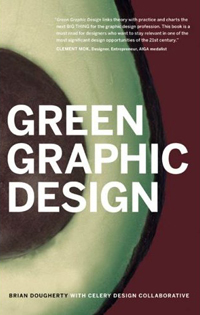Green Graphic Design – Green Books Campaign 2010
“In order to design for change, we must change the way we design.”
— Brian Dougherty with Celery Design Collaborative
I consider myself a “green” designer and stay informed on green issues and initiatives through lectures from the sustainability division of the AIGA and by reading other “green” websites, magazines and books. I look at the practices of paper companies and the environmental goals of corporate giants. I follow “green” wildlife and environmental organizations.
But reading through Brian Dougherty’s easy-to-understand, informative book, Green Graphic Design, with illustrated case studies, has opened my eyes to the very important role we play as designers. The book takes us through the many different components we must be knowledgeable in, if we’re to create real change. We are asked to design backwards. Backwards means to start from the very end and work our way back to those initial ideas in our studio. The stages backward are: waste, user, delivery, warehouse, bindery, printing, and of course conceptualization. Once we break down the design using this system and do our research, we have the ability to rethink each or all of the stages, to be sure we’re creating from the start, the greenest piece we can.
As we move through the chapters, we learn about sustainability, what a company’s core values mean, changing the way we design, which papers to use and why, and new technologies for alternative papers, the paper industries environmental practices and commitments (wind-turbine rather than burning fossil fuels), plastics (which types can be used and recycled and which cannot), and even which colors we shouldn’t specify because they are toxic. Thinking ahead that we should consult with our printer, not just on types of paper (100% post-consumer recycled, bamboo…) and inks (vegetable, soy…) but what size sheet will be used so we can perhaps shrink the size of our design down by 1/2″ and be able to gang up more per sheet.
Do most designers consider these issues? Clients come along and in some cases already have ideas about what they want created. However, imagine the impact just one designer can make if you’re able to change your client’s thinking and print something greener. Now multiply that by all your clients, and then again by all the graphic designers across the planet. That’s a lot of change and the impact it could have on the environment, unreal!
“We are really trying to change the world for the better and graphic designers are empowered to be multimedia change agents, using whatever strategies best drive that change.”
I was quite impressed by the examples shown and the creative and innovative solutions shown by Brian Dougherty and Celery Design. One of my favorites, was the packaging created for a Lemnis Lighting‘s long-lasting bulb. The pyramid-shaped, light-weight design was printed on 100% post-consumer recycled paper. It had no glue to seal it, but interlocking parts. Planning ahead with the printer, they were able to gang up 6 per sheet. Because of the (close to the bulb) pyramid shape they also stack easily, can be stored and shipped neatly. Thinking of the user who buys the product, they even designed the packaging so that it can be unfolded and reused as a lamp shade.
Another cool example is one that I receive every week! Netflix. It comes in simple, thin paper packaging, neatly pulling at the perforated edge to open it and once you’ve watched your movie, you’re able to put the dvd right back in the same packaging and mail it back. Efficient!
Another very important area discussed is a company’s brand and how that gives them the opportunity to communicate to the public. “Green branding” is a form of design activism. Companies are always concerned with how the consumer perceives them. They can’t just talk green without actually doing anything to back it up. They must continue to push through new ideas and strive to prove their mission, if they want us to continue to trust them and buy their products or services. Just imagine what the public thinks about a company who talks the talk and then doesn’t walk the walk! (BP?)
Now you may think this book is all about print marketing and products, but Brian also discusses website design and how companies with the right initiatives can create real change. Using the web to change people’s ideas or teach them the newest or innovative ways to help the environment, can push out there the right feeling about their brand and mission. This makes you care and want to use that company’s services. Example: ZipCars. Easy to use website, and a great idea.
In the back of the book Brian includes a glossary of technical terms such as FSC (Forest Stewardship Council) or TCF (Totally Chlorine-Free bleaching), a sustainability score card and what PMS colors to stay away from due to metals.
Each new assignment that comes in has the opportunity to be greener than it might have been before reading this book. I hope every designer out there will read this important book and together we can have a huge impact and change will come.
This review is part of the Green Books Campaign initiated by Eco-Libris. Today’s second annual event has 200 bloggers reviewing 200 great books, publishing at the same moment, and printed in an environmentally friendly way. Their goal is to encourage publishers to get greener and readers to take the environment into consideration when purchasing books. This campaign organized by Eco-Libris, a green company working to green up the book industry by promoting the adoption of green practices, balancing out books by planting trees, and supporting green books. A full list of participating blogs anbd links to their reviews is available on the Eco-Libris website.
2 thoughts on “Green Graphic Design – Green Books Campaign 2010”
Leave a Reply
You must be logged in to post a comment.



Wow, I never gave much thought to how packages were designed in an eco-friendly way. Wonderful way to rethink marketing and products purchased by consumers.
this sounds excellent. When I’ve needed to source designers and printers I’ve always checked out there environmental credentials and i encouraged my publisher to do the same. This book underlines the importance of the whole production process and sounds like it contains some fascinating details – good case studies too it seems from the ones you’ve shared!